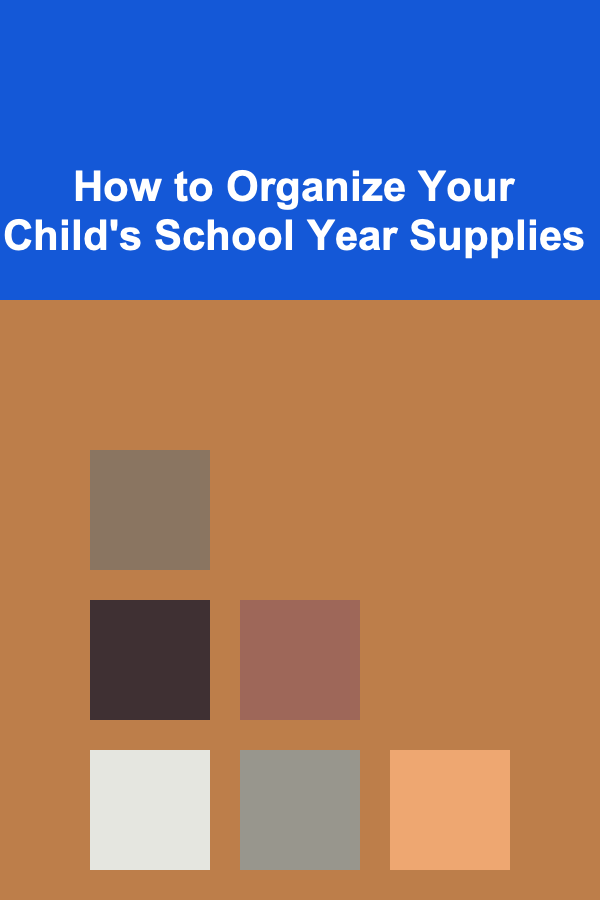
How to Choose the Right Shelving Units for Toy Storage
ebook include PDF & Audio bundle (Micro Guide)
$12.99$11.99
Limited Time Offer! Order within the next:

Choosing the right shelving units for toy storage can significantly enhance both the safety and organization of a child's play area. With an array of options available on the market, selecting the most appropriate shelving unit requires careful consideration of various factors, including the types of toys being stored, available space, aesthetics, and functionality. In this comprehensive guide, we will explore the essential aspects of choosing the right shelving units for toy storage, ensuring that your child's toys are not only stored safely but also easily accessible for playtime.
Understanding Your Needs
2.1. Assessing the Type and Quantity of Toys
Before diving into the world of shelving units, it's crucial to assess the types and quantities of toys you need to store. Different toys have unique storage requirements:
- Small Toys: Action figures, Legos, and other small pieces may require bins or shelves with shallow depths for easy access.
- Large Toys: Stuffed animals, ride-on toys, or bulky building sets may need sturdier shelving with larger spaces.
- Art Supplies: Items like crayons, markers, and paint can benefit from compartments or drawers within the shelving unit.
Take inventory of your child's toys to understand how much space you will need and which types of shelving will best accommodate them.
2.2. Considering Available Space
Measuring your available space is critical when choosing shelving units. Consider the following:
- Room Dimensions: Measure the height, width, and depth of the area where you plan to place the shelving unit.
- Other Furniture: Ensure that the shelves do not obstruct pathways or other furniture in the room.
- Wall Space: If floor space is limited, consider vertical shelving options that utilize wall space efficiently.
A well-measured space will help you find a shelving unit that fits perfectly while optimizing storage.
2.3. Identifying Safety Concerns
Safety is paramount when it comes to storing toys, especially in households with young children. Here are a few safety considerations:
- Stability: Choose shelving units that are sturdy and unlikely to tip over. This is particularly important for taller units.
- Material Safety: Ensure that the materials used in the shelving unit are non-toxic and safe for children.
- Avoid Sharp Edges: Opt for shelving with rounded edges or those that come with safety features to prevent injuries.
Taking these safety concerns into account will help create a secure play environment.
Types of Shelving Units
3.1. Open Shelving
Open shelving units provide easy access to toys and can encourage children to take responsibility for their belongings. They are typically versatile and come in various styles:
- Pros: Quick visibility and easy access; encourages organization.
- Cons: Can become cluttered if not maintained; may require regular cleaning.
3.2. Closed Shelving
Closed shelving units feature doors or drawers that conceal toys. This option can reduce visual clutter and keep toys out of sight when not in use.
- Pros: Keeps toys hidden; can be more aesthetically pleasing; reduces dust accumulation.
- Cons: Less accessible for children; may require adult assistance for younger kids.
3.3. Adjustable Shelving
Adjustable shelving units allow you to customize the heights of the shelves according to the size of the toys. This adaptability makes them suitable for growing collections.
- Pros: Flexible and customizable; can accommodate changing storage needs.
- Cons: May be more expensive; requires assembly.
3.4. Wall-Mounted Shelves
Wall-mounted shelves are great for maximizing floor space. They come in various designs and can be positioned at child-friendly heights.
- Pros: Saves floor space; customizable; adds aesthetic value.
- Cons: Requires installation; may not hold heavier items.
3.5. Corner Shelves
Corner shelving units utilize often-overlooked spaces in the room. These units can be designed to fit snugly in corners, providing additional storage without taking up valuable floor space.
- Pros: Maximizes unused space; can be visually appealing.
- Cons: Limited storage capacity compared to larger units; may require custom design.
Materials for Shelving Units
4.1. Wood
Wooden shelving units are sturdy and can offer a classic aesthetic. They come in various finishes and are durable, making them a popular choice for toy storage.
- Pros: Durable and sturdy; adds warmth to the room; can be refinished.
- Cons: Heavier than other materials; may be more expensive.
4.2. Metal
Metal shelving units are known for their strength and stability. They are often used in industrial-style designs and can hold a substantial amount of weight.
- Pros: Extremely durable; easy to clean; resistant to pests.
- Cons: Can be cold in appearance; may have sharp edges if not designed properly.
4.3. Plastic
Plastic shelving units are lightweight and often less expensive. They come in various colors and designs, making them perfect for children's spaces.
- Pros: Lightweight; easy to move; resistant to moisture and stains.
- Cons: May not be as strong as wood or metal; can become brittle over time.
4.4. Composite Materials
Composite materials, such as engineered wood or MDF (medium-density fiberboard), offer a balance between durability and cost. These materials can mimic the look of solid wood while being lower in price.
- Pros: Cost-effective; can have a similar appearance to wood; lighter than solid wood.
- Cons: May not be as durable; can be susceptible to moisture damage.
Design Considerations
5.1. Aesthetic Appeal
The visual appeal of shelving units should complement the overall decor of the room. Choosing designs that resonate with your child's interests can enhance the play area.
- Opt for units with themes or colors that reflect your child's personality.
- Consider furniture that matches other pieces in the room for a cohesive look.
5.2. Color and Finish
The color and finish of the shelving unit can influence the mood of the space. Bright colors can energize a playroom, while neutral tones can create a calming atmosphere.
- Choose finishes that are easy to clean, especially in play areas.
- Look for non-toxic paints and finishes to ensure safety.
5.3. Size and Dimensions
Select shelving units that are proportionate to the space they will occupy. Oversized units can overwhelm a small room, while too-small units may not provide enough storage.
- Consider the height of the shelving unit based on your child's reach.
- Ensure that the unit is not too tall to prevent tipping hazards.
Functionality and Features
6.1. Weight Capacity
Check the weight capacity of the shelving unit to ensure it can support the toys you plan to store. Heavier toys should be placed on lower shelves to maintain stability.
- Review manufacturer specifications for weight limits.
- Distribute weight evenly across shelves to avoid tipping.
6.2. Mobility
If you anticipate needing to move the shelving unit, consider options with wheels or casters. Mobile shelving can make it easier to rearrange the play area or clean underneath.
- Ensure that the wheels lock in place for safety.
- Choose units that are lightweight enough to move easily.
6.3. Safety Features
Look for shelving units with safety features, such as anchored systems or anti-tip mechanisms, especially for taller units. These features can prevent accidents and keep children safe during play.
- Check for rounded corners and edges to prevent injuries.
- Ensure that heavy items are stored low to minimize risk.
Budgeting for Shelving Units
7.1. Understanding Cost Factors
The cost of shelving units varies based on factors such as material, size, and brand. Higher-quality materials and custom designs will typically come at a premium.
- Set a budget before shopping to narrow down your options.
- Be aware of potential extra costs, such as delivery and installation.
7.2. Finding Affordable Options
There are many ways to find affordable shelving units without sacrificing quality:
- Sales and Discounts: Keep an eye out for seasonal sales or clearance events.
- Second-Hand Options: Consider thrift stores, online marketplaces, or garage sales for gently used units.
- DIY Solutions: Building your own shelving unit can save money and allow for customization.
Where to Buy Shelving Units
8.1. Online Retailers
Online retailers offer a vast selection of shelving units and often provide customer reviews for informed purchasing decisions. Some popular options include:
- Amazon: A wide variety of shelving units available with user ratings.
- Wayfair: Specializes in home goods, including decorative and functional shelving.
- IKEA: Known for affordable, stylish, and functional furniture.
8.2. Physical Stores
Visiting physical stores allows you to see and touch the shelving units before buying. This can help you gauge the quality and suitability for your needs. Consider checking out:
- Home improvement stores: Such as Home Depot or Lowe's, which offer a range of shelving solutions.
- Furniture stores: Many local and chain furniture stores carry shelving units designed for children's rooms.
- Specialty stores: Stores focusing on children's furniture may offer unique options tailored for toy storage.
Setting Up Your Shelving Unit for Toy Storage
9.1. Sorting and Categorizing Toys
Once you've selected and purchased your shelving unit, it's time to set it up! Begin by sorting toys into categories, such as:
- Action Figures: Group all action figures together in one section.
- Building Blocks: Keep building sets organized in bins or boxes.
- Art Supplies: Use drawers or containers specifically for art-related items.
9.2. Organizing by Accessibility
Position the most frequently used toys at eye level or within easy reach for your child. Less frequently used items can be stored on higher shelves or in less accessible areas.
- Arrange toys based on age appropriateness; younger children should have easier access to toys they can play with safely.
- Use the bottom shelves for larger items and the top shelves for items that are less often used.
9.3. Labeling for Easy Identification
Labels can significantly enhance organization, especially for children who are learning to read. Consider these labeling strategies:
- Picture Labels: Use images alongside text for younger children who may not yet recognize words.
- Color-Coded Labels: Assign different colors to different categories to make identification easier.
- Magnetic Labels: These can be easily changed as toy collections evolve.
Maintaining Your Shelving Units
10.1. Regular Cleaning
Keeping the shelving unit clean is essential for both hygiene and aesthetics. Establish a cleaning routine that includes:
- Dusting: Regularly dust shelves to prevent grime buildup.
- Wipe Down: Use non-toxic cleaners to wipe surfaces and remove any sticky residue or spills.
10.2. Periodic Checks for Safety
Schedule regular safety checks of the shelving unit to ensure stability and structural integrity. Look for:
- Signs of wear or damage, such as loose screws or weakened joints.
- Proper anchoring or stability for taller units.
Conclusion
Choosing the right shelving units for toy storage is a multifaceted process that involves understanding your needs, exploring various options, and considering safety, functionality, and aesthetics. By taking the time to assess your child's toys and the space available, you can select shelving that not only enhances organization but also contributes to a safe and inviting play environment.
Investing in quality shelving units will simplify toy storage, making it easier for children to access their belongings and maintain order. With the right approach, you can create a functional and visually appealing space that encourages creativity and responsibility in your child's playtime activities.

Beginner's Guide to Building a Personal Brand
Read More
How to Create a Floor Plan for Your New Home
Read More
How to Host a Party Without Overwhelming Yourself
Read More
How to Improve Home Security with Door and Window Upgrades
Read More
How to Organize Your Child's School Year Supplies
Read More
Navigating the Future of Cloud Architecture: Trends, Technologies, and Best Practices
Read MoreOther Products

Beginner's Guide to Building a Personal Brand
Read More
How to Create a Floor Plan for Your New Home
Read More
How to Host a Party Without Overwhelming Yourself
Read More
How to Improve Home Security with Door and Window Upgrades
Read More
How to Organize Your Child's School Year Supplies
Read More